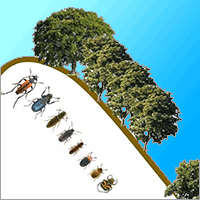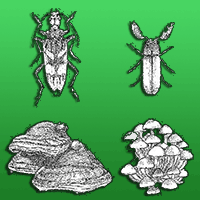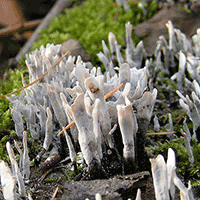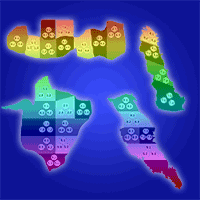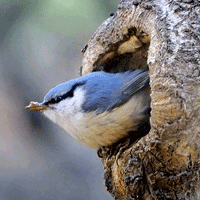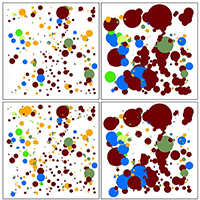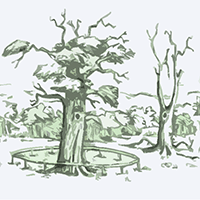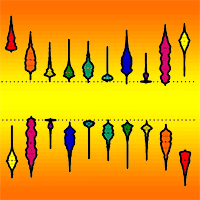In the managed beech forests of Central Italy (Molise), the diversity of saproxylic species is potentially under threat by intensive management. To evaluate the impact of forestry on the biodiversity of these ecosystems, we analyzed the relationship between abundance of saproxylic beetles and (i) forest stand exposure and elevation, (ii) deadwood availability (coarse woody debris - CWD - and stumps), (iii) abundance of microhabitats. Four sampling sectors with different altitudes and exposure were identified in a 400-ha study area in the Appenine mountains. Fifteen circular plots (13 m radius) were established in each sector where deadwood and microhabitats were surveyed and saproxylic beetles sampled. We fitted joint species distribution models to quantify the relationship between forest attributes and saproxylic species’ abundance, including the interactions with their family and trophic category. Overall, 2334 specimens belonging to 64 species of saproxylic beetles were collected. Both abundance and species richness were higher in the sectors with high elevation (respectively, 55% and 44%) and South exposure (respectively, 28% and 44%). Average deadwood volumes were low (stumps: 7.6 m3 ha-1; CWD: 0.3 m3 ha-1; snags: 0.4 m3 ha-1), and insect galleries were the most abundant microhabitat (380 records over a total of 434). The most important variables affecting abundance were stump characteristics (model deviance = 81.2), elevation (deviance = 64.7), and CWD characteristics (deviance = 58.0). Our results show that topographical variables and forest structure jointly affect the abundance patterns of saproxylic beetle communities in managed beech forests. These ecological interactions imply that management has different impacts on the saproxylic communities in different topographic conditions. To acknowledge this complexity we advocate for a landscape-level forest management supporting the local beetle diversity maintaining a mosaic of semi-natural forest characteristics in different topographic contexts. The ecological value of the forest landscape will be further enhanced by the application of closer-to-nature management interventions based on deadwood retention, microhabitat creation and tree retention, in line with the guidelines of the new EU Forest Strategy for 2030.
Keywords
, , , , , ,
Citation
Parisi F, Mazziotta A, Vangi E, Tognetti R, Travaglini D, Marchetti M, D’Amico G, Francini S, Borghi C, Chirici G (2023). Exposure elevation and forest structure predict the abundance of saproxylic beetles’ communities in mountain managed beech forests. iForest 16: 155-164. - doi: 10.3832/ifor4264-016
Academic Editor
Marco Borghetti
Paper history
Received: Nov 14, 2022
Accepted: Mar 14, 2023
First online: Jun 08, 2023
Publication Date: Jun 30, 2023
Publication Time: 2.87 months
© SISEF - The Italian Society of Silviculture and Forest Ecology 2023
Open Access
This article is distributed under the terms of the Creative Commons Attribution-Non Commercial 4.0 International (https://creativecommons.org/licenses/by-nc/4.0/), which permits unrestricted use, distribution, and reproduction in any medium, provided you give appropriate credit to the original author(s) and the source, provide a link to the Creative Commons license, and indicate if changes were made.

Breakdown by View Type
(Waiting for server response...)
Article Usage
Total Article Views: 22517
(from publication date up to now)
Breakdown by View Type
HTML Page Views: 17284
Abstract Page Views: 3052
PDF Downloads: 1751
Citation/Reference Downloads: 1
XML Downloads: 429
Web Metrics
Days since publication: 924
Overall contacts: 22517
Avg. contacts per week: 170.58
Article Citations
Article citations are based on data periodically collected from the Clarivate Web of Science web site
(last update: Mar 2025)
Total number of cites (since 2023): 2
Average cites per year: 0.67
Publication Metrics
by Dimensions ©
Articles citing this article
List of the papers citing this article based on CrossRef Cited-by.
(1)
Basile M, Parisi F, Tognetti R, Francini F, Lombardi F, Marchetti M, Travaglini D, De Santis E, Chirici G (2023)Diversity of beetle species and functional traits along gradients of deadwood suggests weak environmental filtering. Forest Ecosystems, 100090.
CrossRef |
Gscholar
(2)
Bollmann K, Braunisch V (2013)To integrate or to segregate: balancing commodity production and biodiversity conservation in European forests. In: “Integrative Approaches as an Opportunity for the Conservation of Forest Biodiversity” (Kraus D, Krumm F eds). European Forest Institute, Freiburg, Germany, pp. 284.
Gscholar
(3)
Bouchard P, Bousquet Y, Davies AE, Alonso-Zarazaga MA, Lawrence JF, Lyal CHC, Newton AF, Reid CAM, Schmitt M, Slipinski SA, Smith ABT (2011)Family-group names in Coleoptera (Insecta). ZooKeys 88: 1-972.
CrossRef |
Gscholar
(4)
Bouget C, Brustel H, Brin A, Noblecourt T (2008)Sampling saproxylic beetles with window flight traps: methodological insights. Revue d’Ecologie, Terre et Vie 10: 21-32.
Online |
Gscholar
(5)
Bouget C, Nusillard B, Pineau X, Ricou C (2012)Effect of deadwood position on saproxylic beetles in temperate forests and conservation interest of oak snags. Insect Conservation and Diversity 5 (4): 264-278.
CrossRef |
Gscholar
(6)
Brunet J, Isacsson G (2009)Influence of snag characteristics on saproxylic beetle assemblages in a south Swedish beech forest. Journal of Insect Conservation 13: 515-528.
CrossRef |
Gscholar
(7)
Bütler R, Lachat T, Larrieu L, Paillet Y (2013)Habitat trees: key elements for forest biodiversity. In: “Integrative Approaches as an Opportunity For the Conservation of Forest Biodiversity” (Kraus D, Krumm F eds). European Forest Institute, Freiburg, Germany, pp. 284.
Online |
Gscholar
(8)
Campanaro A, Parisi F (2021)Open datasets wanted for tracking the insect decline: let’s start from saproxylic beetles. Biodiversity Data Journal 9: e72741.
CrossRef |
Gscholar
(9)
Carpaneto GM, Mazziotta A, Coletti G, Luiselli L, Audisio P (2010)Conflict between insect conservation and public safety: the case study of a saproxylic beetle (
Osmoderma eremita) in urban parks. Journal of Insect Conservation 14 (5): 555-565.
CrossRef |
Gscholar
(10)
Carpaneto GM, Baviera C, Biscaccianti AB, Brandmayr P, Mazzei A, Mason F, Battistoni A, Teofili C, Rondinini C, Fattorini S, Audisio P (2015)A red list of Italian saproxylic beetles: taxonomic overview, ecological features and conservation issues (Coleoptera). Fragmenta Entomologica 47: 53-126.
CrossRef |
Gscholar
(11)
Drag L, Burner RC, Stephan JG, Birkemoe T, Doerfler I, Gossner MM, Magdon P, Ovaskainen O, Potterf M, Schall P, Snäll T, Sverdrup-Thygeson A, Weisser W, Müller J (2022)High resolution 3D forest structure explains ecomorphological trait variation in assemblages of saproxylic beetles. Functional Ecology 37 (1): 150-161.
CrossRef |
Gscholar
(12)
Edelmann P, Ambarli D, Gossner MM, Schall P, Ammer C, Wende B, Schulze ED, Wolfgang WW, Seibold S (2022)Forest management affects saproxylic beetles through tree species composition and canopy cover. Forest Ecology and Management 524: 120532.
CrossRef |
Gscholar
(13)
European Environment Agency (2006)European forest types: categories and types for sustainable forest management - Reporting and Policy. Office for Official Publications of the European Communities, Copenhagen, Denmark, pp. 111.
Online |
Gscholar
(14)
European Commission (2021)New EU Forest Strategy for 2030. Communication from the Commission to the European Parliament, the Council, the European Economic and Social Committee and the Committee of the Regions, COM(2021) 572 Final. European Commission, Brussels, Belgium, pp. 27.
Online |
Gscholar
(15)
Gao T, Nielsen AB, Hedblom M (2015)Reviewing the strength of evidence of biodiversity indicators for forest ecosystems in Europe. Ecological Indicators 57: 420-434.
CrossRef |
Gscholar
(16)
Götmark F, Asegård E, Franc N (2011)How we improved a landscape study of species richness of beetles in woodland key habitats, and how model output can be improved. Forest Ecology and Management 262 (12): 2297-2305.
CrossRef |
Gscholar
(17)
Harvey PH, Pagel MD (1991)The comparative method in evolutionary biology (Vol. 239). Oxford University Press, Oxford, UK, pp. 248.
Gscholar
(18)
Hui FKC, Poisot T (2016)Boral-Bayesian ordination and regression analysis of multivariate abundance data in R. Methods in Ecology and Evolution 7: 744-750.
CrossRef |
Gscholar
(19)
Johansson T, Gibb H, Hjältén J, Dynesius M (2017)Soil humidity, potential solar radiation and altitude affect boreal beetle assemblages in dead wood. Biological Conservation 209: 107-118.
CrossRef |
Gscholar
(20)
Kraus D, Bütler R, Krumm F, Lachat T, Larrieu L, Mergner U, Paillet Y, Rydkvist T, Schuck A, Winter S (2016)Catalogue of tree microhabitats - reference field list Integrate + Technical Paper, European Forest Institute, Freiburg, Germany, pp. 16.
Online |
Gscholar
(21)
Leidinger J, Weisser WW, Kienlein S, Blaschke M, Jung K, Kozak J, Fischer A, Mosandl R, Michler B, Ehrhardt M, Zech A, Saler D, Graner M, Seibold S (2020)Formerly managed forest reserves complement integrative management for biodiversity conservation in temperate European forests. Biological Conservation 242: 108437.
CrossRef |
Gscholar
(22)
Lindhe A, Lindelöw A, Asenblad N (2005)Saproxylic beetles in standing dead wood density in relation to substrate sun-exposure and diameter. Biodiversity and Conservation 14 (12): 3033-3053.
CrossRef |
Gscholar
(23)
Lindman L, Ockinger E, Ranius T (2022)Microclimatic conditions mediate the effect of deadwood and forest characteristics on a threatened beetle species,
Tragosoma depsarium. Oecologia 199 (3): 737-752.
CrossRef |
Gscholar
(24)
Lombardi F, Lasserre B, Chirici G, Tognetti R, Marchetti M (2012)Deadwood occurrence and forest structure as indicators of old-growth forest conditions in Mediterranean mountainous ecosystems. Ecoscience 19: 344-355.
CrossRef |
Gscholar
(25)
Lombardi F, Marchetti M, Corona P, Merlini P, Chirici G, Tognetti R, Burrascano S, Alivernini A, Puletti N (2015)Quantifying the effect of sampling plot size on the estimation of structural indicators in old-growth forest stands. Forest Ecology and Management 346: 89-97.
CrossRef |
Gscholar
(26)
Mawdsley JR (2003)The importance of species of Dasytinae (Coleoptera: Melyridae) as pollinators in western North America. The Coleopterists Bulletin 57 (2): 154-160.
CrossRef |
Gscholar
(27)
Marage D, Lemperiere G (2005)The management of snags: a comparison in managed and unmanaged ancient forests of the Southern French Alps. Annals of Forest Science 62: 135-142.
CrossRef |
Gscholar
(28)
Mazziotta A, Borges P, Kangas A, Halme P, Eyvindson K (2023)Spatial trade-offs between ecological and economical sustainability in the boreal production forest. Journal of Environmental Management 330: 117144.
CrossRef |
Gscholar
(29)
Müller J, Bütler R (2010)A review of habitat thresholds for dead wood: a baseline for management recommendations in European forests. European Journal of Forest Research 129 (6): 981-992.
CrossRef |
Gscholar
(30)
Nocentini S, Travaglini D, Bart M (2022)Managing Mediterranean forests for multiple ecosystem services: research progress and knowledge gaps. Current Forestry Reports 8: 229-256.
CrossRef |
Gscholar
(31)
Ovaskainen O, Abrego N (2020)Joint species distribution modeling. with applications in R. Cambridge University Press, Cambridge, UK, pp. 372.
Online |
Gscholar
(32)
Paletto A, De Meo I, Cantiani P, Ferretti F (2014)Effects of forest management on the amount of deadwood in Mediterranean oak ecosystems. Annals of Forest Science 71 (7): 791-800.
CrossRef |
Gscholar
(33)
Parisi F, Pioli S, Lombardi F, Fravolini G, Marchetti M, Tognetti R (2018)Linking deadwood traits with saproxylic invertebrates and fungi in European forests - A review. iForest - Biogeosciences and Forestry 11 (3): 423.
CrossRef |
Gscholar
(34)
Parisi F, Di Febbraro M, Lombardi F, Biscaccianti AB, Campanaro A, Tognetti R, Marchetti M (2019)Relationships between stand structural attributes and saproxylic beetle abundance in a Mediterranean broadleaved mixed forest. Forest Ecology and Management 432: 957-966.
CrossRef |
Gscholar
(35)
Parisi F, Lombardi F, Marziliano PA, Russo D, De Cristofaro A, Marchetti M, Tognetti R (2020a)Diversity of saproxylic beetle communities in chestnut agroforestry systems. iForest - Biogeosciences and Forestry 13: 456-465.
CrossRef |
Gscholar
(36)
Parisi F, Platia G, Mancini M, De Cristofaro A (2020b)Confirmation of
Crepidophorus mutilatus (Rosenhauer, 1847) in Italy (Coleoptera: Elateridae), with notes on its distribution and conservation. Coleopterists Bulletin 74 (3): 489-494.
CrossRef |
Gscholar
(37)
Parisi F, Innangi M, Tognetti R, Lombardi F, Chirici G, Marchetti M (2021)Forest stand structure and coarse woody debris determine the biodiversity of beetle communities in Mediterranean mountain beech forests. Global Ecology and Conservation 28: e01637.
CrossRef |
Gscholar
(38)
Parisi F, Vangi E, Francini S, Chirici G, Travaglini D, Marchetti M, Tognetti R (2022a)Monitoring the abundance of saproxylic red-listed species in a managed beech forest by landsat temporal metrics. Forest Ecosystems 9: 100050.
CrossRef |
Gscholar
(39)
Parisi F, Francini S, Borghi C, Chirici G (2022b)An open and georeferenced dataset of forest structural attributes and microhabitats in central and southern Apennines (Italy). Data in Brief 43: 108445.
CrossRef |
Gscholar
(40)
Scarascia-Mugnozza G, Oswald H, Piussi P, Radoglou K (2000)Forests of the Mediterranean region: gaps in knowledge and research needs. Forest Ecology and management 132 (1): 97-109.
CrossRef |
Gscholar
(41)
Seibold S, Bässler C, Brandl R, Gossner MM, Thorn S, Ulyshen MD, Müller J (2015)Experimental studies of deadwood biodiversity a review identifying global gaps in knowledge. Biological Conservation 191: 139-149.
CrossRef |
Gscholar
(42)
Seibold S, Bässler C, Brandl R, Büche B, Szallies A, Thorn S, Ulyshen MD, Müller J (2016)Microclimate and habitat heterogeneity as the major drivers of beetle diversity in dead wood. Journal of Applied Ecology 53 (3): 934-943.
CrossRef |
Gscholar
(43)
Thomas JW (2002)Dead wood: from forester’s bane to environmental boon. In: Proceedings of the Symposium “Ecology and Management of Deadwood in Western Forests” (Laudenslayer WF Jr, Shea PJ, Valentine BE, Weatherspoon CP, Lisle TE eds). Reno (NV, USA). USDA Forest Service General Technical Report PSW-GTR-181, pp. 3-9.
Gscholar
(44)
Thorn S, Förster B, Heibl C, Müller J, Bässler C (2018)Influence of macroclimate and local conservation measures on taxonomic, functional, and phylogenetic diversities of saproxylic beetles and wood-inhabiting fungi. Biodiversity and Conservation 27 (12): 3119-3135.
CrossRef |
Gscholar
(45)
Thorn S, Seibold S, Leverkus AB, Michler T, Müller J, Noss RF, Stork N, Vogel S, Lindenmayer DB (2020a)The living dead: acknowledging life after tree death to stop forest degradation. Frontiers in Ecology and the Environment 18 (9): 505-512.
CrossRef |
Gscholar
(46)
Thorn S, Chao A, Bernhardt-Römermann M, Chen YH, Georgiev KB, Heibl C, Müller J, Schäfer H, Bässler C (2020b)Rare species, functional groups, and evolutionary lineages drive successional trajectories in disturbed forests. Ecology 101 (3): e02949.
CrossRef |
Gscholar
(47)
Tognetti R, Smith M, Panzacchi P (2022)Climate-smart forestry in mountain regions. Series “Managing Forest Ecosystems”, vol. 40, Springer, Cham, Switzerlands, pp. 587.
CrossRef |
Gscholar
(48)
Travaglini D, Barbati A, Chirici G, Lombardi F, Marchetti M, Corona P (2007)ForestBIOTA data on deadwood monitoring in Europe. Plant Biosystems 141: 222-230.
Gscholar
(49)
Wang Y, Neuman U, Wright S, Warton DI (2012)mvabund: an R package for model-based analysis of multivariate abundance data. Methods in Ecology and Evolution 3: 471-473.
CrossRef |
Gscholar
(50)
Wermelinger B, Flückiger PF, Obrist MK, Duelli P (2007)Horizontal and vertical distribution of saproxylic beetles (Col., Buprestidae, Cerambycidae, Scolytinae) across sections of forest edges. Journal of Applied Entomology 131 (2): 104-114.
CrossRef |
Gscholar
(51)
Wu J, Pan H, Zhang J, Yang S, Zhao M (2015)Effect of sun exposure on saproxylic beetle assemblages may change with topoclimate in a subtropical forest of east China. Journal of Insect Conservation 19 (5): 877-889.
CrossRef |
Gscholar
(52)
Zumr V, Remeš J, Pulkrab K (2021)How to increase biodiversity of saproxylic beetles in commercial stands through integrated forest management in Central Europe. Forests 12 (6): 814.
CrossRef |
Gscholar
